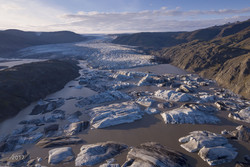Glaciers in Iceland continue to retreat
The mass balance of the Icelandic glaciers has been negative since 1995 with the exception of the year 2015 when it became positive for the first time in 20 years. The mass balance in 2016 was again negative by a similar magnitude as in recent years. The mass balance of Langjökull and Hofsjökull was again negative in 2017 whereas Vatnajökull was almost in balance. The glaciers have lost approximately 250 km3 of ice since 1995, which corresponds to ca. 7% of their total volume. Glaciers in Iceland have retreated rapidly for more than two decades and glacier downwasting is one of the most obvious consequences of a warming climate in the country.
The Icelandic Meteorological Office, The Institute of Earth Sciences, University of Iceland and the Southeast Iceland Nature Centre have published a newsletter briefly describing glacier changes since about 1900 along with the results of monitoring of glacier termini, glacier mass balance and crustal movements induced by glacier changes in recent years.
Since 2000, the area of Iceland's glaciers has reduced by more than 600 km2, and by ca. 2000 km2 from the end of the 19th century when the glaciers reached their maximum extent since the country was settled in the 9th century CE. The glacier area has on average been reduced by ca. 40 km2 annually in recent years. Glaciers typically retreated by tens of metres in 2017. Kaldalónsjökull and E-Hagafellsjökull hold the 2017 record in the terminus variations dataset of the Iceland Glaciological Society, retreating by 100–200 m in a year. The Breiðamerkurjökull outlet glacier of the Vatnajökull ice cap retreats even faster, where it calves into Jökulsárlón lagoon, with an annual rate of retreat in recent years up to 200–300 m.
The Hoffellsjökull outlet glacier in Hornafjörður has retreated and thinned greatly since the end of the 19th century, when the glacier reached its maximum extent in recent times. The foreland of Hoffellsjökull provides unique opportunities to observe the geomorphological effects of glacier retreat. In 2010, the retreat of the glacier led to the formation of a terminus lake that has grown rapidly every year since then. The area of Hoffellsjökull has been reduced by ca. 40 km² since the end of the 19th century and by more than 0.5 km² annually in recent years.


Birds eye views of the tongue of Hoffellsjökull in 1982 and 2017. The views are produced from aerial photographs taken from an aircraft in 1982 and a UAV in 2017 and show well the formation of the terminus lake and the lowering of the glacier surface over the 35 year period.




